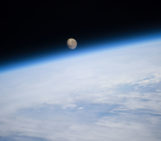
How can geoscience methods be incorporated into the research of extrasolar planets? These are planets that are beyond our own solar system and their geological properties are mostly unknown.
Kaustubh Hakim is a postdoctoral researcher at the Center for Space and Habitability in Bern, Switzerland where he studies the interiors of rocky exoplanets and geochemical cycles using theory and lab experiments. In this week’s blog post, he bridges the gap between geosciences and exoplanetary science.

Kaustubh Hakim
Historically, the research in disciplines within geosciences has been driven by observations on Earth. Since the 1950s geoscientists also began looking up to the sky. The Apollo missions retrieved rocks from the Moon and facilitated the visit of the only geoscientist, Harrison Schmitt, to the Moon. Following that, a number of space missions were sent to our neighbouring planets, albeit without human occupants (so far). Martian science took a leap with the historic NASA Pathfinder mission in the late 1990s with the first robotic rover to operate on Mars. Today, a number of orbiters, landers and rovers are collecting data on several planetary bodies and advancing our understanding of the solar system by implementing techniques and methods perfected in the geosciences.
In 1995, the recent Nobel laureates, Michel Mayor and Didier Queloz, discovered the first planet outside our solar system orbiting a Sun-like star. During the past 25 years, more than 4000 extra-solar planets (exoplanets) have been discovered, and this number is expected to be more than doubled in the next decade. With every new discovery, some baffling facts were placed in front of astronomers. Soon it was clear that our solar system is not an average planetary system. Moreover, exoplanets likely exhibit a larger chemical and physical diversity than that of the Earth and solar system planetary bodies.
During the past decade, numerous exoplanets more or less the size of Earth were detected. Based on a bulk density estimate, these exoplanets are expected to be “rocky” just like the inner four planets of the solar system and popularly known as rocky exoplanets. The next-generation space and ground-based telescopes will send us data on the composition and abundance of gases in the atmospheres of rocky exoplanets. Then we would like to ask ourselves: What can these gases tell us about the planet’s interior and surface dynamics and mineralogy? What is the origin of these gases? Is it because of life or abiotic processes?
Obtaining the answer is not going to be simple, since it also depends on the progress of interdisciplinary research in the near future. In addition to astronomy, physics, chemistry and biology, geosciences have a key role to play in seeking answers to a number of questions surrounding exoplanet science. The biggest challenge is to interpret observational data. Although the data obtained from a specific exoplanet lack details, exoplanets allow for statistical studies because of their large tally. This is in some way opposite to what geosciences deals with: Many observations from a single planet. Does that mean we cannot apply geoscientific tools and reasoning to exoplanet science?
No. We have a crucial role to play. Most systems studied by geoscientists are complex, if not chaotic. Consequently, geoscience models cannot be explained with a clean, compact theory and are typically calibrated to observations to a certain extent. For exoplanet applications, these techniques need to be modified in a way that they rely more on theoretical models, laboratory experiments and global and statistical data, and less on specialized and regional data. Such a strategy might not work all the time. Nonetheless, the best aspect of this approach is that insights from the geosciences can be extended beyond solely the realm of Earth, utilising Earth-based lab measurements and observations.
For instance, high-pressure high-temperature properties of minerals discovered on Earth have been studied in mineral physics and petrology for more than a century. Analyses of lunar mineralogy pushed researchers to explore the properties of minerals and rocks that were not studied in detail earlier. In the same way, rocky exoplanets potentially possess a diversity in mineralogy that has never been explored in petrology. Statistical data on the chemical composition of planet-hosting stars tells us about the extent of this diversity. It is possible to use this range of diversity to study the high-pressure high-temperature properties of minerals that are rare or absent on Earth. This directly assists modellers to exert better control over global, observable properties of exoplanets, most notably mass and radius which are primary data obtained by exoplanet observations.
There are a number of such examples exhibiting the need for implementing geoscientific methods to study exoplanets. Traditional geoscientists have an eye for detail. Exoplanet science requires explaining large-scale properties. By sacrificing on some of the model “tuning” that is commonplace in the geosciences and instead focusing on improving the predictive power in a general sense, geoscientists will become gamechangers for interpreting exoplanet data. The application of geoscience to exoplanet science needs to be done with an open mind with the quest to understand the big picture: Why is our home planet the third planet from the Sun, and not the first planet from Proxima Centauri?



